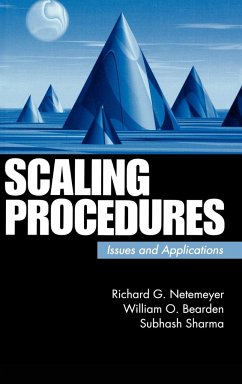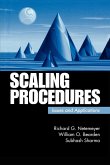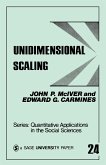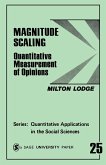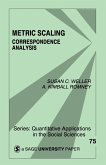- Gebundenes Buch
- Merkliste
- Auf die Merkliste
- Bewerten Bewerten
- Teilen
- Produkt teilen
- Produkterinnerung
- Produkterinnerung
PLEASE UPDATE SAGE UK AND SAGE INDIA ADDRESSES ON IMPRINT PAGE.
Andere Kunden interessierten sich auch für
![Scaling Procedures Scaling Procedures]() Richard G. NetemeyerScaling Procedures119,99 €
Richard G. NetemeyerScaling Procedures119,99 €![Meta-Analytic Procedures for Social Research Meta-Analytic Procedures for Social Research]() Robert RosenthalMeta-Analytic Procedures for Social Research88,99 €
Robert RosenthalMeta-Analytic Procedures for Social Research88,99 €![Unidimensional Scaling Unidimensional Scaling]() John P. McIverUnidimensional Scaling40,99 €
John P. McIverUnidimensional Scaling40,99 €![Magnitude Scaling Magnitude Scaling]() Milton LodgeMagnitude Scaling40,99 €
Milton LodgeMagnitude Scaling40,99 €![Metric Scaling Metric Scaling]() Susan C. WellerMetric Scaling40,99 €
Susan C. WellerMetric Scaling40,99 €![Primer in Theory Construction Primer in Theory Construction]() Paul Davidson ReynoldsPrimer in Theory Construction43,99 €
Paul Davidson ReynoldsPrimer in Theory Construction43,99 €![Trends in cardiac procedures Trends in cardiac procedures]() Daminda WeerasingheTrends in cardiac procedures51,99 €
Daminda WeerasingheTrends in cardiac procedures51,99 €-
-
-
Produktdetails
- Produktdetails
- Verlag: Sage Publications
- Seitenzahl: 224
- Erscheinungstermin: 1. März 2003
- Englisch
- Abmessung: 240mm x 161mm x 17mm
- Gewicht: 505g
- ISBN-13: 9780761920267
- ISBN-10: 0761920269
- Artikelnr.: 21432300
- Herstellerkennzeichnung
- Libri GmbH
- Europaallee 1
- 36244 Bad Hersfeld
- gpsr@libri.de
- Verlag: Sage Publications
- Seitenzahl: 224
- Erscheinungstermin: 1. März 2003
- Englisch
- Abmessung: 240mm x 161mm x 17mm
- Gewicht: 505g
- ISBN-13: 9780761920267
- ISBN-10: 0761920269
- Artikelnr.: 21432300
- Herstellerkennzeichnung
- Libri GmbH
- Europaallee 1
- 36244 Bad Hersfeld
- gpsr@libri.de
Richard G. Netemeyer is the Ralph E. Beeton Professor of Free Enterprise in the Marketing Division and Senior Associate Dean at the McIntire School of Commerce at the University of Virginia, Charlottesville, VA. He received his Ph.D. in Business Administration with a specialization in Marketing from the University of South Carolina in 1986. He was a member of the Marketing faculty at the E. J. Ourso School of Business at Louisiana State University from 1986 to 2001. In 2001, he joined the McIntire School of Commerce. Professor Netemeyer's research has appeared in the Journal of Consumer Research, Journal of Marketing Research, Journal of Marketing, Journal of Applied Psychology, OBHDP, Marketing Science, American Journal of Psychiatry, American Journal of Public Health, and others. He is a co-author of two textbooks pertaining to measurement and psychometrics, and is a member of the editorial review boards of Journal of Consumer Research, Journal of Marketing, and the Journal of Public Policy & Marketing.
About the Authors
Chapter One: Introduction and Overview
Purpose of the Book.
Perspectives on Measurement in the Social Sciences.
Latent Constructs
Overview of dimensionality, reliability, and validity
Overview of recommended procedures and steps in scale development.
Chapter Two: Dimensionality
Introduction.
Dimensionality of construct, items, and a set of items.
Does uni-dimensionality of a set of items imply uni-dimensionality of items
or construct?
Relevance of uni-dimensionality.
How to assess dimensionality of constructs.
Chapter Three: Reliability
Introduction
The true-score model
Coefficient alpha
Generalizability Theory
Chapter Four: Validity
Overview of Construct Validity
Translation validity
Criterion validity
Convergent and discriminant validity
Known-group validity
Nomological validity
Chapter Five: Steps 1 and 2: Construct Definition and Generating and
Judging Measurement items Chapter 5: Steps 1 and 2: Construct Definition
and Judging Measurement Items
Introduction
Step 1: Construct definition and content domain
Step 2: Generating and judging measurement items
Applications of Steps 1 and 2.
Chapter Six: Step 3: Designing and Conducting Studies to Develop the Scale
Introduction
Pilot testing
Conducting multiple studies for initial development and validation
Initial item analyses: Exploratory factor analysis (EFA)
Initial item and reliability analyses
A final caveat
EFA and item and reliability analyses examples from the literature
Chapter 7: Step 4: Finalizing the Scale
Introduction
EFA and additional item analyses
Confirmatory Factor Analyses (CFA)
Additional evaluations of validity
Establishing norms
Applying generalizability theory
Chapter Eight: Concluding Remarks
Index
Chapter One: Introduction and Overview
Purpose of the Book.
Perspectives on Measurement in the Social Sciences.
Latent Constructs
Overview of dimensionality, reliability, and validity
Overview of recommended procedures and steps in scale development.
Chapter Two: Dimensionality
Introduction.
Dimensionality of construct, items, and a set of items.
Does uni-dimensionality of a set of items imply uni-dimensionality of items
or construct?
Relevance of uni-dimensionality.
How to assess dimensionality of constructs.
Chapter Three: Reliability
Introduction
The true-score model
Coefficient alpha
Generalizability Theory
Chapter Four: Validity
Overview of Construct Validity
Translation validity
Criterion validity
Convergent and discriminant validity
Known-group validity
Nomological validity
Chapter Five: Steps 1 and 2: Construct Definition and Generating and
Judging Measurement items Chapter 5: Steps 1 and 2: Construct Definition
and Judging Measurement Items
Introduction
Step 1: Construct definition and content domain
Step 2: Generating and judging measurement items
Applications of Steps 1 and 2.
Chapter Six: Step 3: Designing and Conducting Studies to Develop the Scale
Introduction
Pilot testing
Conducting multiple studies for initial development and validation
Initial item analyses: Exploratory factor analysis (EFA)
Initial item and reliability analyses
A final caveat
EFA and item and reliability analyses examples from the literature
Chapter 7: Step 4: Finalizing the Scale
Introduction
EFA and additional item analyses
Confirmatory Factor Analyses (CFA)
Additional evaluations of validity
Establishing norms
Applying generalizability theory
Chapter Eight: Concluding Remarks
Index
About the Authors
Chapter One: Introduction and Overview
Purpose of the Book.
Perspectives on Measurement in the Social Sciences.
Latent Constructs
Overview of dimensionality, reliability, and validity
Overview of recommended procedures and steps in scale development.
Chapter Two: Dimensionality
Introduction.
Dimensionality of construct, items, and a set of items.
Does uni-dimensionality of a set of items imply uni-dimensionality of items
or construct?
Relevance of uni-dimensionality.
How to assess dimensionality of constructs.
Chapter Three: Reliability
Introduction
The true-score model
Coefficient alpha
Generalizability Theory
Chapter Four: Validity
Overview of Construct Validity
Translation validity
Criterion validity
Convergent and discriminant validity
Known-group validity
Nomological validity
Chapter Five: Steps 1 and 2: Construct Definition and Generating and
Judging Measurement items Chapter 5: Steps 1 and 2: Construct Definition
and Judging Measurement Items
Introduction
Step 1: Construct definition and content domain
Step 2: Generating and judging measurement items
Applications of Steps 1 and 2.
Chapter Six: Step 3: Designing and Conducting Studies to Develop the Scale
Introduction
Pilot testing
Conducting multiple studies for initial development and validation
Initial item analyses: Exploratory factor analysis (EFA)
Initial item and reliability analyses
A final caveat
EFA and item and reliability analyses examples from the literature
Chapter 7: Step 4: Finalizing the Scale
Introduction
EFA and additional item analyses
Confirmatory Factor Analyses (CFA)
Additional evaluations of validity
Establishing norms
Applying generalizability theory
Chapter Eight: Concluding Remarks
Index
Chapter One: Introduction and Overview
Purpose of the Book.
Perspectives on Measurement in the Social Sciences.
Latent Constructs
Overview of dimensionality, reliability, and validity
Overview of recommended procedures and steps in scale development.
Chapter Two: Dimensionality
Introduction.
Dimensionality of construct, items, and a set of items.
Does uni-dimensionality of a set of items imply uni-dimensionality of items
or construct?
Relevance of uni-dimensionality.
How to assess dimensionality of constructs.
Chapter Three: Reliability
Introduction
The true-score model
Coefficient alpha
Generalizability Theory
Chapter Four: Validity
Overview of Construct Validity
Translation validity
Criterion validity
Convergent and discriminant validity
Known-group validity
Nomological validity
Chapter Five: Steps 1 and 2: Construct Definition and Generating and
Judging Measurement items Chapter 5: Steps 1 and 2: Construct Definition
and Judging Measurement Items
Introduction
Step 1: Construct definition and content domain
Step 2: Generating and judging measurement items
Applications of Steps 1 and 2.
Chapter Six: Step 3: Designing and Conducting Studies to Develop the Scale
Introduction
Pilot testing
Conducting multiple studies for initial development and validation
Initial item analyses: Exploratory factor analysis (EFA)
Initial item and reliability analyses
A final caveat
EFA and item and reliability analyses examples from the literature
Chapter 7: Step 4: Finalizing the Scale
Introduction
EFA and additional item analyses
Confirmatory Factor Analyses (CFA)
Additional evaluations of validity
Establishing norms
Applying generalizability theory
Chapter Eight: Concluding Remarks
Index

